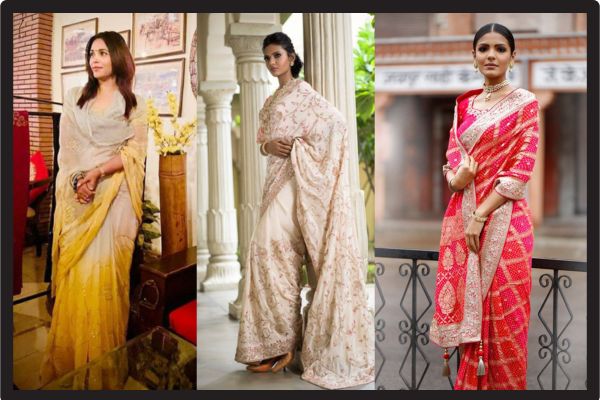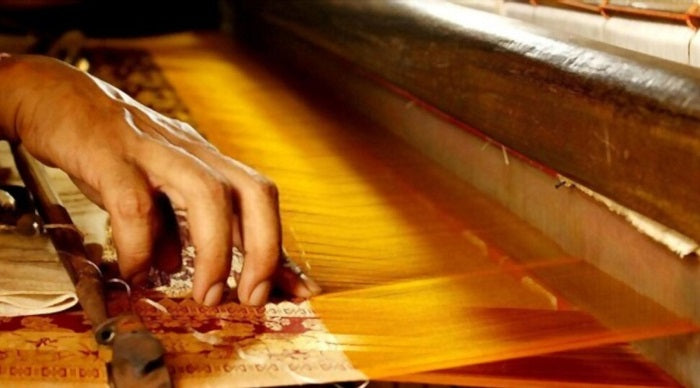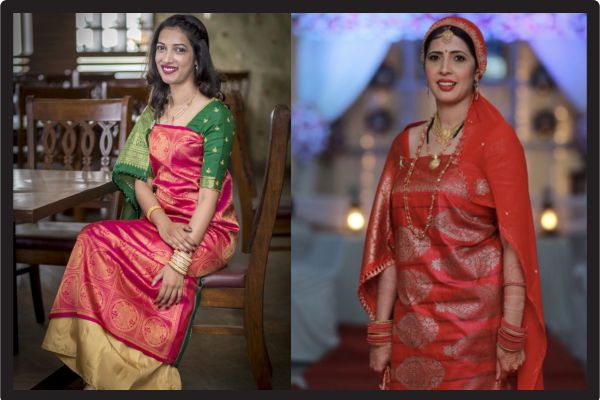
Rajasthani Style Saree Draping: Wear It In Proper Steps
Rajasthani style saree draping is a traditional way of wearing a saree that showcases the vibrant culture of Rajasthan. Whether you're attending a traditional folk festival or a wedding, mastering this draping style adds grace and elegance to your appearance.
The Rajasthani saree draping style not only highlights curvy figures but also gives a classic saree look, which has been beloved for generations. With the right blouse pattern and careful pleat design, this style consists of intricate designs that enhance the overall aesthetic, making it a popular choice among Indian women.
Understanding the Significance of Rajasthani Saree Draping Style
The significance of Rajasthani saree draping styles lies in its rich cultural heritage and the unique way it reflects the traditions of Rajasthan. This traditional drape is not just about wearing a saree, it's about showcasing the essence of Marwadi culture and the vibrant life of Rajasthan.
- Cultural Reflection: Rajasthani saree draping styles represent the traditional values and social customs of the region. Each pleat and fold in the saree have a specific meaning, often tied to the Marwadi saree draping style.
- Royal Elegance: The style exudes a royal and elegant look, often seen in the way Rajputi women wear their sarees.
- Versatility: Whether it’s a wedding or a traditional festival, Rajasthani saree draping is versatile, suitable for various occasions.
Incorporating these elements, the Rajasthani style becomes a symbol of grace and tradition in Indian fashion.
Essential Preparations for Rajasthani Saree Draping
Preparing for Rajasthani saree draping is important to achieve the perfect saree style that represents elegance and tradition. Here are the essential steps:
- Choosing the Saree: Start with selecting a traditional saree that reflects Rajasthani culture, such as a Bandhani Saree or Leheriya saree. The fabric should be lightweight yet durable, allowing for easy pleating and draping.
- Blouse and Petticoat: A well-fitted blouse and petticoat are fundamental. The petticoat should be tied securely at the waist, ensuring that it supports the saree's weight. The blouse should complement the saree’s colour and design, enhancing the overall look.
- Gathering Accessories: Keep all necessary accessories, like safety pins, handy. These will help in securing the pleats and saree pallu, ensuring the saree stays in place.
- Mirror Check: Finally, ensure you have a full-length mirror to check your drape from every angle.
These preparations ensure that your Rajasthani saree draping is flawless and comfortable, reflecting the beauty of this timeless saree style.
Also read about: Silk Saree Blouse Designs Ideas
Step-by-Step Guide to Wear Saree in Rajasthani Style
Step 1: Preparing the Saree for Draping
Start by holding the saree at one end and tucking it in securely around your waist. Ensure that the saree is firmly tucked in and touches the floor slightly. This traditional way of starting the drape ensures that the saree stays in place, providing a firm foundation for the rest of the draping process.
Adjust the length to ensure it covers your ankles but does not restrict movement. This careful preparation is essential to achieve the full essence of the Rajasthani saree draping style.
Step 2: Tucking the Saree Around the Waist
Continue by wrapping the saree around your waist once more, bringing it back to the front. The saree should be wrapped tightly to maintain a classic look and prevent it from loosening throughout the day. Ensure that the saree firmly sits above the navel, which is also common in popular saree draping styles like the Bengali saree draping style, Gujarati saree draping style, and Marwadi style draping.
This step is important in achieving a neat and tidy look, especially when wearing the saree for formal events or traditional celebrations.
Step 3: Creating and Securing the Pleats
Next, start creating the pleats. The pleated style drape is one of the highlights of Rajasthani saree draping. Gather the fabric at the center and make around 5-7 pleats, ensuring they are equal in width. These pleats should be secured with safety pins to keep them in place.
Carefully tuck the pleats into the petticoat slightly to the left of the navel. This step not only provides a distinct look but also adds to the comfort and ease of movement, which is essential for any saree style.
Step 4: Draping the Pallu in Rajasthani Style
The pallu, an essential part of the saree draping, is what differentiates the Rajasthani style from others like the Nauvari saree drape style or South Indian saree draping. For the Rajasthani style, the pallu is taken from the back to the front over the right shoulder, with the fabric covering the chest.
The end of the pallu is then brought around to the back and tucked at the waist. This draping style not only enhances the elegance of the saree but also reflects the cultural richness of Rajasthan.
Step 5: Final Adjustments for a Perfect Fit
Once the saree is draped, make the final adjustments to ensure it is comfortable and looks flawless. Adjust the saree pleats and pallu to ensure they are neatly arranged and secured. The pleats should be smooth and the pallu should fall gracefully, creating a traditional yet stylish look.
This step is important in achieving the perfect saree drape, especially for special occasions where every detail matters. Ensure that the saree fits well and allows for easy movement, making it not only beautiful but also practical.
Exploring Different Styles of Rajasthani Saree Draping
1. Rajputi Style: The Traditional Royal Drape
The Rajputi style saree drape is the most traditional and royal form of Rajasthani saree draping. This style is characterized by its elaborate pleats and the way the pallu is draped over the right shoulder, often covering the head. The Rajputi style is commonly worn during royal events and traditional folk festivals, symbolizing the grandeur of Rajasthan’s heritage.
This draping style has been passed down through generations and remains one of the most beloved styles in Indian fashion, particularly in Rajasthan.
2. Bandhani Saree Draping: Adding Vibrance and Colour
Bandhani sarees are an integral part of Rajasthani culture, known for their vibrant colors and intricate tie-dye patterns. The Bandhani saree draping style involves creating bigger pleats and allowing the colourful pallu to take center stage. This style is popular during festive occasions like Garba nights and traditional celebrations.
The bright colors and unique patterns of Bandhani sarees make them a favourite among those looking to add a splash of colour to their wardrobe. This style highlights curvaceous figures, making it a hit among women of all ages.
3. Modern Adaptations: Blending Tradition with Contemporary Fashion
While traditional drapes like the Rajputi and Bandhani remain popular, modern adaptations of Rajasthani saree draping have also emerged. These adaptations often involve blending traditional elements with a contemporary twist, such as using lighter, air fabrics or adding a leather belt to cinch the waist.
The pallu might be draped in an unconventional manner, similar to the mermaid’s tail drape seen in other saree styles. These modern styles allow for more experimentation while still maintaining the essence of Rajasthani saree draping, making them suitable for various occasions.
Tips for Achieving the Perfect Rajasthani Saree Drape
1. Maintaining Comfort and Ease of Movement
Comfort is key when it comes to Rajasthani saree draping. To maintain ease of movement, ensure that the saree is draped tightly but not too tight. The saree pleats should be neatly arranged to prevent tripping, and the pallu should be secure yet flexible.
This allows for easy movement, whether you're attending a formal event or a traditional folk festival. The use of lightweight, breathable fabrics like cotton or khun fabric can also enhance comfort, especially during long hours of wear.
2. Using Safety Pins and Other Techniques for Secure Draping
Safety pins are essential for keeping your saree drape secure throughout the day. Use pins to hold the pleats in place and to secure the pallu over the shoulder. This is particularly important for styles like the Rajputi and Bandhani, where the pallu needs to be firmly fixed.
Additionally, consider using binder clips for extra pleating precision, especially when draping in popular Indian cinemas-inspired styles. These techniques ensure that your saree remains perfectly in place, even during busy and active events.
3. Enhancing Your Look with the Right Jewellery and Accessories
To complete your Rajasthani saree draping look, carefully choose accessories that complement the saree. Traditional jewellery such as bangles, necklaces, and maang tikka can enhance the beauty of the drape. For a more modern touch, consider adding a belt or pairing the saree with statement earrings.
The right accessories can elevate your entire look, making it suitable for various occasions, from weddings to formal gatherings. Remember, the accessories you choose should not only match the saree but also highlight its intricate designs.
Final Words
Mastering the Rajasthani style saree draping can be a rewarding experience, allowing you to embrace a piece of India’s rich cultural heritage. Whether you prefer the traditional Rajputi style or modern adaptations, this guide provides you with the steps and tips needed to achieve a perfect drape.
Remember to pay attention to details, from the way you secure your pleats to the accessories you choose. With practice, you can confidently wear this beautiful saree style and make a lasting impression at any event.
FAQs
Which saree is famous in Rajasthan?
In Rajasthan, the Bandhani saree is the most famous, known for its vibrant colors and intricate tie-dye patterns. This saree is often worn during traditional celebrations and festivals, symbolizing the cultural richness of the region.
How to wear a front side saree?
To wear a front side saree, begin by tucking the saree around your waist from the right side. Bring the saree around to the left and create pleats at the front, ensuring they are even. Next, drape the pallu over your left shoulder, allowing it to hang in the front.
How to wear attractive saree?
To wear an attractive saree, choose one that complements your body type, secure pleats and pallu with pins, and accessorize with suitable jewellery. Experiment with draping styles to find your perfect look.
Btw, at Pratibha Sarees, you can find not only bandhani or leheriya sarees but also Pure Silk Sarees, Banarasi Sarees, Dola Silk Sarees, and much more. Visit our website today.
Here is what our audience is currently reading:
Top and Best Saree Brands in India
Latest Saree Trends with Designs You Should Follow
How to Identify a Pure Kanjivaram Silk Saree
Types of Saree Fabrics and Materials



Leave a comment
This site is protected by hCaptcha and the hCaptcha Privacy Policy and Terms of Service apply.